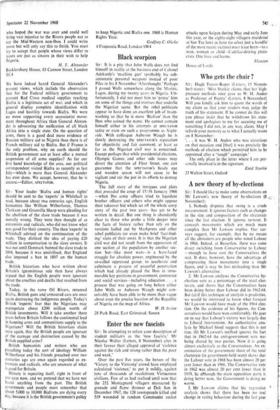A new theory of by-elections
Sir: I should like to make some observations on Mr Lawson's new theory of by-elections (8 November): 1. Nobody disputes that swing is a crude measurement. It ignores factors such as changes in the size and composition of the electorate since the last election. It ignores turnout. It conceals movements which are much more complex than Mr Lawson implies. Our sur- veys suggest, for example, that by no means all the abstainers are people who voted Labour in 1966. Indeed, at Bassetlaw, there was some direct switching from Conservative to Labour —enough to have cost the Conservatives the seat. It does, however, have the advantage of compressing these movements into a single figure, and it may be less misleading than Mr Lawson's alternative.
2. Mr Lawson analyses the Conservative by- election vote as a percentage of the total elec- torate, and shows that the Conservatives have been doing better than Labour did in 1962-64. But (a) if this technique of analysis is predictive, we would be interested to know what forecast Mr Lawson would have made of the 1964 elec- tion. On the evidence of his figures, the Con- servatives would have won comfortably. He goes on to say that Labour's victory was largely due to Liberal intervention. An authoritative ana- lysis by Michael Steed suggests that this is not true. (b) Mr Lawson's method ignores the fact that in 1962-64 the anti-government vote was being shared by two parties. Now it is going almost exclusively to the Conservatives. An ex- amination of the government share of the total electorate (in government-held seats) shows that the Labour vote in 1968 has been almost 20 per cent lower than in 1966. The Conservative vote in 1962 was almost 20 per cent lower than in 1959. So although the main opposition party is doing better now, the Government is doing no worse.
3. Mr Lawson claims that his regression analysis shows that there has been no real change in voting behaviour during the last year or so, and that there is a basic underlying swing to the Tories of 7.6 per cent. Mr David Butler (Letters, 15 November) pointed out that there is considerable evidence for thinking that there has been a change of opinion during the last twelve months. Furthermore, Mr Lawson's analysis which relates the fall in turnout to the crude swing to the Tories, depends on the sweep- ing assumption that the vast majority of ab- stainers are people who would otherwise vote Labour. Our evidence suggests that differential turnout does not work as strongly as this. At recent by-elections, our surveys, without any adjustment for turnout, would have produced voting estimates not significantly different from the actual results. These same by-elections show considerable inter-party switching which reveals a further interesting trend. At the Cambridge by-election, 11 per cent of those who voted Labour in 1966 said they would vote Conserva- tive. The comparable figure at Gorton was 14 per cent, at Dudley 24 per cent. at Brightside 14 per cent and at Bassetlaw 11 per cent. Fin- ally, if Mr Lawson's regression technique were a satisfactory way of analysing by-elections, it should hold true of periods other than 1967-68. In fact, however, a similar graph for 1962-64 in Conservative-held seats does not suggest any relationship between swing and turnout.
One factual point, Mr Lawson is wrong to say that, assuming an unchanged turnout and an unchanged third-party vote, the Conservatives need to increase their poll by 2.3 per cent to win in 1970. An increase of 2.3 per cent (as a proportion of the total electorate) would give them as many votes as Labour but it would only win them about forty seats. The Conserva- tives need an increase of about 3.5 per cent to win an overall majority.
Frank Teer Joint Managing Director, NOP Ltd, 76/86 Strand, London WC2
Nigel Lawson writes: (i) My model was, in- evitably, an oversimplification of actual voting behaviour. The conventional concept of 'swing' involves, however, an even greater degree of oversimplification—and is, for by-election analysis, totally misleading, however 'con- venient' it may be. (ii) No analysis can be predictive; the future is inherently unpredic- table, and the psephologists' job is to try to understand the present and past (which may of course help us to guess at the future). (iii) I did not state that Labour's 1964 victory was 'largely due to Liberal intervention.' (iv) I'm afraid I have little faith in Mr Teer's uncritical accep- tance either of the answers to his by-election questionnaires or of the short-term fluctuations in the opinion polls—witness last week's apparent 10 per cent rise in the Tory lead. (v) As for 1962-64, 1962 was, as I wrote, the Liberals' annus tnirabilis, and for that year all analysis on a two-party basis breaks down. But the 1963-64 by-elections do, in fact, show a clear relationship between swing and turnout. I shall return both to this and to other points in a later article.



































 Previous page
Previous page